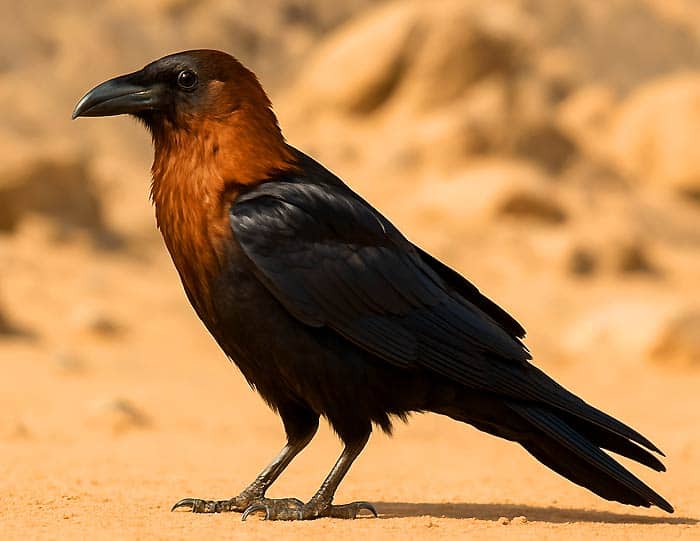
| Animalia | Passeriformes | Corvidae | Corvus | Corvus ruficollis |
The brown-necked raven (Corvus ruficollis) is a distinctive member of the Corvidae family, notable for its adaptability to some of the harshest environments on Earth. This species is primarily distributed across North Africa, the Middle East, and parts of southwestern Asia, where it thrives in arid and semi-arid landscapes.
Recognized for its intelligence and resourcefulness, the brown-necked raven has long fascinated ornithologists and bird enthusiasts alike. Its presence in folklore and local cultures further highlights its significance in the regions it inhabits. Unlike many other types of birds, the brown-necked raven has evolved a suite of physical and behavioral adaptations that allow it to survive in deserts and open terrains where food and water are often scarce.
Table of Contents
- Common Name: Brown-necked raven.
- Family: Corvidae
- Body Dimensions: 52-56 cm in length, 103-120 cm in wingspan.
- Male Plumage Colors: Brownish-black head, glossy black body.
- Female Plumage Colors: Brownish-black head, glossy black body.
- Habitat: Deserts, oases, palm groves.
- Diet: Omnivorous: carrion, various types of insects, fruit, human waste.
- Native Countries: Algeria, Morocco, Kenya, Iran, and more.
- Continents: Africa, Asia
Brown-necked Raven Characteristics
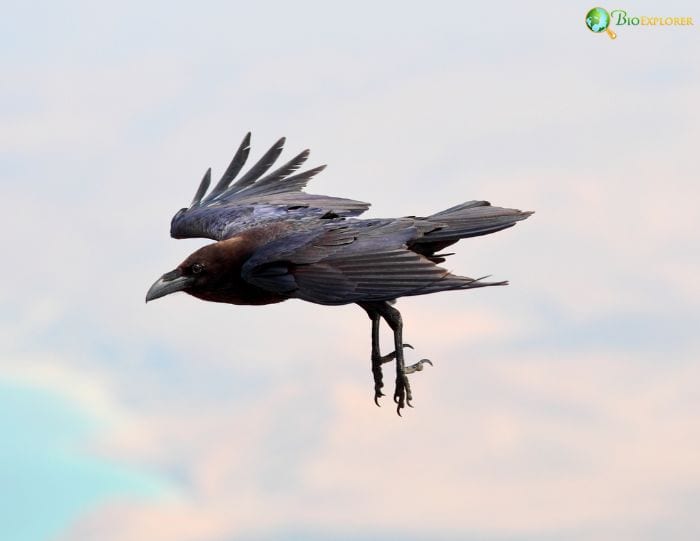
The brown-necked raven is a medium to large-sized corvid, measuring approximately 52 to 56 cm in length.
- Its most distinguishing feature is the brownish coloration on the neck and upper breast, which contrasts with the otherwise glossy black plumage covering the rest of its body.
- This brownish hue is especially prominent in good lighting and provides the basis for the species’ common name.
- The feathers on the neck are often shaggy, giving the bird a somewhat scruffy appearance compared to the somewhat sleeker white-necked raven (Corvus albicollis).
- The bill of the brown-necked raven is strong, thick, and slightly arched.
- Its legs and feet are robust, adapted for walking and hopping on the ground as it forages.
- The wings are long and pointed, facilitating strong, direct flight over open landscapes. The tail is wedge-shaped, though less pronounced than in some other raven species, such as the thick-billed raven (Corvus crassirostris).
Juvenile brown-necked ravens resemble adults but tend to have duller plumage and less pronounced brown coloring on the neck.
- Molting patterns and plumage condition can vary with age and environmental factors, sometimes making field identification challenging, especially where their range overlaps with similar species.
- Vocalizations are another key trait, with this raven producing a range of calls, including deep croaks and guttural notesWhat is guttural notes?Guttural notes are deep, harsh vocal sounds produced in the throat. They're common in bird calls, metal vocals, and languages with throaty consonants., which are often used for communication between individuals or to signal alarm.
Brown-necked Raven Habitat
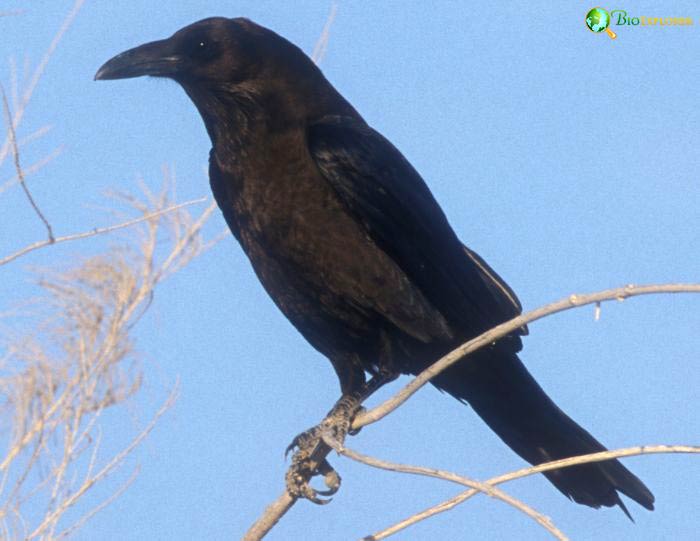
The brown-necked raven is primarily associated with arid and semi-arid environments, including deserts, rocky hills, and dry open plains, making it one of the notable desert birds.
- Its range encompasses the Sahara and Sahel regions of North Africa, the Middle East, and extends into southwestern Asia.
- The species is notably absent from densely forested areas and is rarely found in humid regions, unlike other birds of Africa and Asia.
Habitats favored by the brown-necked raven are characterized by sparse vegetation, scattered trees or shrubs, and abundant rocky outcrops or cliffs that provide nesting sites.
- The bird is also known to exploit human-altered landscapes, such as agricultural fields and settlements, particularly where food resources are available.
- Its adaptability to a variety of dry habitats underlines its ecological flexibility and resilience in the face of environmental challenges.
- In parts of eastern and southern Africa, the Cape crow (Corvus capensis) can be found in overlapping or adjacent habitats.
- Although similar in size, the Cape crow tends to occupy more temperate grasslands and agricultural zones and is easily distinguished by its slender bill and entirely black plumage.
What Do Brown-necked Ravens Eat?
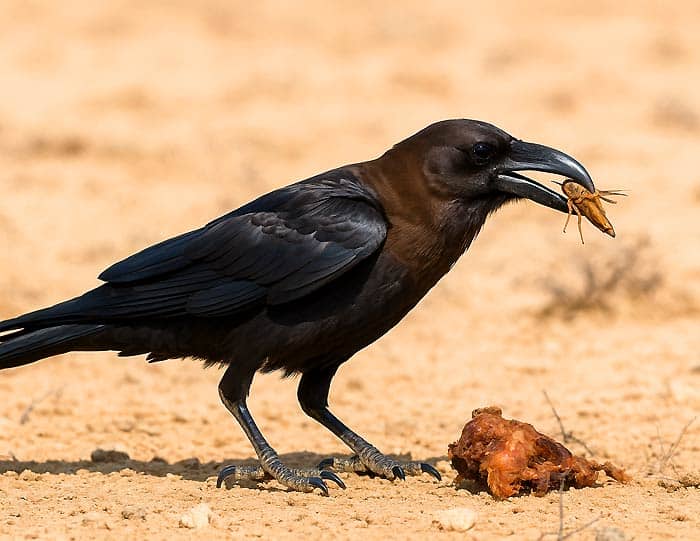
The brown-necked raven is an opportunistic omnivore, feeding on a wide range of food items depending on availability.
- Its diet includes insects, small vertebrates, carrion, seeds, fruits, and even human waste.
- This dietary flexibility allows the species to thrive in environments where food sources are unpredictable or scarce.
- The raven is particularly adept at exploiting ephemeral food resources, such as locust swarms or animal carcasses, and is known to scavenge alongside other desert-dwelling animals.
Foraging behavior is typically ground-oriented, with individuals or pairs walking or hopping as they search for food.
- The species is also capable of aerial foraging, especially when catching flying insects or investigating potential food sources from above. brown-necked ravens have been observed using their strong bills to dig for insects or probe into crevicesWhat is crevices?Crevices are narrow cracks or openings, often found in rocks or walls. for hidden prey.
- In addition to natural food sources, the brown-necked raven often takes advantage of human activities, scavenging at rubbish dumps, roadkill, or agricultural sites. This behavior not only reflects the species’ intelligence but also its ability to adapt to changing environmental conditions and exploit novel resources.
Cooperative foraging and food sharing have been documented, particularly among mated pairs or family groups.
Breeding Behavior
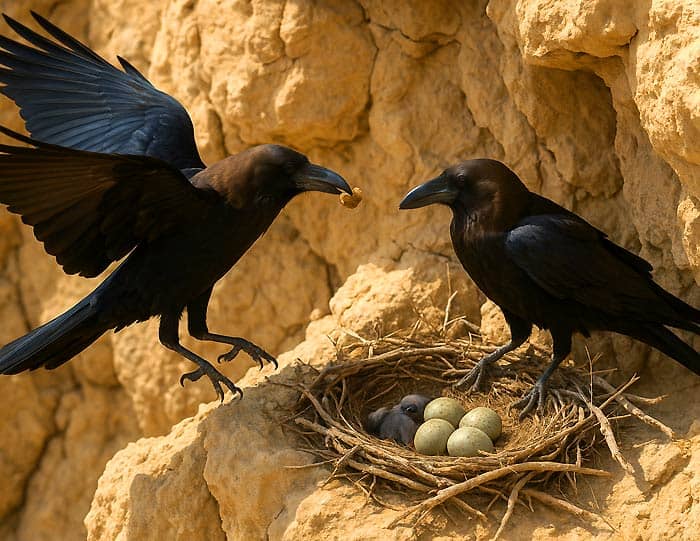
Breeding in the brown-necked raven typically occurs during the cooler months, varying by region but often coinciding with periods of increased food availability.
- The species is monogamousWhat is monogamous?In biology, monogamous refers to a mating system in which an individual has an exclusive reproductive partnership with a single mate during a breeding season or for life., with pairs forming long-term bonds that may persist across multiple breeding seasons.
- Courtship displays involve aerial acrobatics, mutual preening, and the exchange of food items, all of which serve to reinforce pair bonds.
Nesting sites are usually selected on cliffs, rocky outcrops, or tall trees, providing both safety from predators and a wide vantage point over the surrounding landscape.
- The nest itself is a bulky structure made of sticks, lined with softer materials such as hair, wool, or feathers.
- Both members of the pair participate in nest construction, though the female typically takes the lead in arranging the lining.
- Clutch size ranges from 3 to 5 eggs, which are pale greenish or bluish with darker blotches.
- The female is primarily responsible for incubation, which lasts approximately 20-22 days. During this period, the male provides food for the incubating female and guards the nest against potential threats.
After hatching, both parents are involved in feeding and caring for the chicks.
- The nestlings remain in the nest for about 35-42 days, during which time they are fed a diet rich in protein to support rapid growth.
- Fledglings continue to receive parental care for several weeks after leaving the nest, gradually learning to forage and fend for themselves.
- Breeding success is influenced by food availability, predation, and environmental conditions, with pairs often reusing successful nesting sites in subsequent years.
Interactions with Other Wildlife
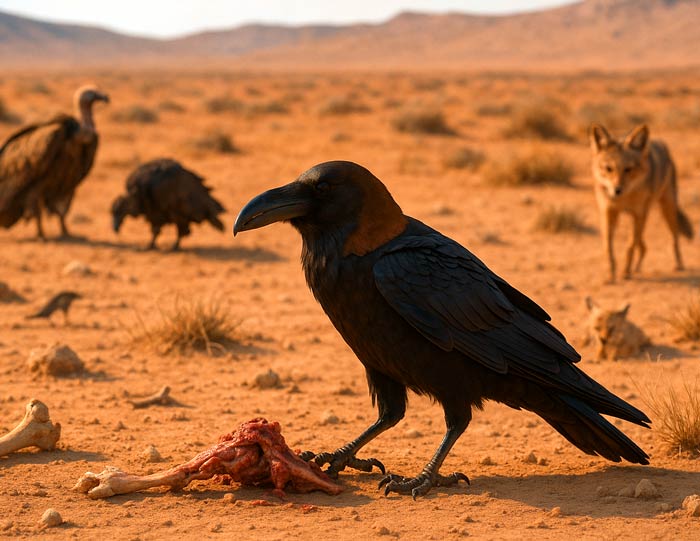
The brown-necked raven interacts with a variety of other wildlife species within its habitat.
- As a scavenger, it often competes with other birds and types of mammals for access to carrion and other food resources.
- Its presence at carcasses can attract or deter scavengers, depending on the size and dominance of the competing species.
In addition to competition, the brown-necked raven may engage in mutualistic relationships, such as alerting animals to the presence of predators or food sources through its vocalizations.
- The species is also known to prey on the eggs and young of other birds, which can influence local avian community dynamics.
- Despite these interactions, the raven is generally not considered a significant threat to wildlife populations due to its broad diet and opportunistic feeding habits.
Ecological Importance
The brown-necked raven is currently listed as Least Concern on the IUCN Red List, reflecting its wide distribution and stable population trends.
- The species is not believed to be facing any major threats at a global scale, although localized declines may occur due to habitat degradation, persecution, or changes in food availability.
- Its adaptability to a range of environments, including human-altered landscapes, has contributed to its resilience in the face of environmental change.
- From an ecological perspective, the brown-necked raven plays a vital role as both a scavenger and predator, helping to control populations of insects and small vertebrates while facilitating the breakdown of carrion. Its presence can influence nutrient cycling and the structure of local food webs.
Continued monitoring is recommended by scientists to detect any emerging threats, particularly as human activities and climate change alter desert ecosystems. The conservation of the brown-necked raven is important not only for maintaining biodiversity but also for preserving the ecological functions it supports.
Brown-necked Raven Fun Facts
- The brown-necked raven has been recorded as a rare vagrant in regions far outside its core range. The species had its first documented appearance in Lebanon in 2022, surprising local ornithologists and expanding knowledge of its dispersal abilities.
- In some areas, the brown-necked raven is locally known for its curiosity and has been observed approaching human camps or settlements, sometimes investigating unfamiliar objects left behind.
- The species’ scientific name, ruficollis, comes from Latin roots meaning “red-necked“, though the actual color is more of a brownish tinge.
- While the brown-necked raven is known for its shaggy neck feathers and dry habitat preference, other members of the Corvus genus like the Torresian crow (Corvus orru) display quite different ecological traits.
- The species has been observed nesting in highly inaccessible locations, such as abandoned buildings, demonstrating a preference for security over convenience.
- The brown-necked raven is occasionally observed engaging in aerial play, such as tumbling or chasing other birds, outside of breeding or foraging contexts.
Frequently Asked Questions
Are there any subspecies of the brown-necked raven?
Yes, there are recognized subspecies, including Corvus ruficollis ruficollis and Corvus ruficollis sardonius, which differ only slightly in size and plumage across their ranges.
How do researchers identify brown-necked ravens in the field?
Field identification relies on a combination of plumage features, vocalizations, and habitat preferences, with special attention to the brownish neck and overall structure.
Is the brown-necked raven considered a migratory species?
The brown-necked raven is generally resident throughout its range, though some local movements may occur in response to food availability or climatic conditions.
Are there any ongoing research projects focused on this species?
Recent studies have documented range expansions and breeding records in new areas, such as Lebanon, and ongoing research continues to fill gaps in knowledge about its ecology and behavior.
How does the Chihuahuan raven compare to the brown-necked raven?
Although both species inhabit arid environments, the Chihuahuan raven (Corvus cryptoleucus) is native to the southwestern United States and northern Mexico, while the brown-necked raven ranges across North Africa and southwestern Asia. The Chihuahuan raven is slightly smaller, has a shorter bill, and features a rounder tail compared to the slightly wedge-shaped tail of the brown-necked raven. It also lacks the brownish neck coloring that gives the brown-necked raven its name.
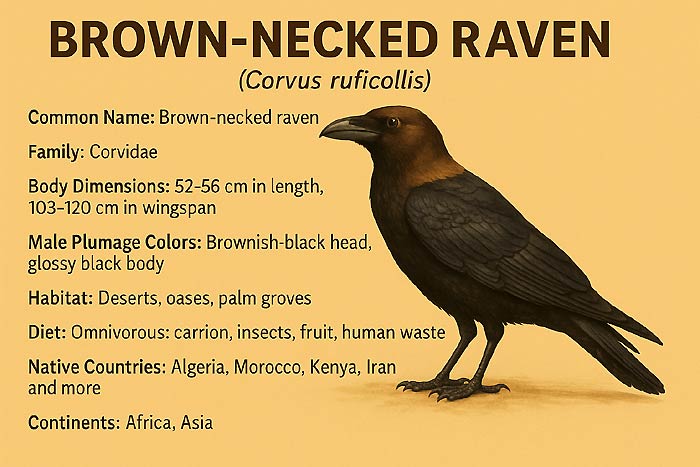
The brown-necked raven is a remarkable bird, distinguished by its intelligence and adaptability.
Occupying a wide range of habitats across eastern and southern Africa, it plays a vital role in its ecosystem as both a scavenger and a predator. Its complex social behaviors, problem-solving abilities, and capacity to thrive in both wild and urban environments underscore its ecological success. Continued monitoring and habitat protection will be essential to ensure the ongoing health of brown-necked raven populations.
![]()











